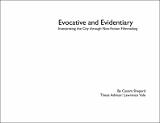| dc.contributor.advisor | Lawrence Vale. | en_US |
| dc.contributor.author | Shepard, Cassim (Cassim Cauldwell) | en_US |
| dc.contributor.other | Massachusetts Institute of Technology. Dept. of Urban Studies and Planning. | en_US |
| dc.date.accessioned | 2008-09-02T17:57:03Z | |
| dc.date.available | 2008-09-02T17:57:03Z | |
| dc.date.copyright | 2007 | en_US |
| dc.date.issued | 2007 | en_US |
| dc.identifier.uri | http://hdl.handle.net/1721.1/42063 | |
| dc.description | Thesis (M.C.P.)--Massachusetts Institute of Technology, Dept. of Urban Studies and Planning, 2007. | en_US |
| dc.description | This electronic version was submitted by the student author. The certified thesis is available in the Institute Archives and Special Collections. | en_US |
| dc.description | Page 159 blank. | en_US |
| dc.description | Includes bibliographical references (p. 150-158). | en_US |
| dc.description.abstract | This thesis interrogates the relationship between non-fiction film and urban discourse. It outlines intellectual and visual strategies at play in a selection of non-fiction films that actively assign meaning to the mutual influence of urban form and social processes. In so doing, I identify two overlapping traditions, the evocative and the evidentiary, which classify the applications of filmmaking to the interpretation of cities. The research focuses on two American urban planning films that represent radically different ways of organizing their visual content in order to advocate a specific kind of urban reform: The City (1939) by Willard Van Dyke and Ralph Steiner and The Social Life of Small Urban Spaces (1980) by William H Whyte. Each case requires a thorough contextualization and location with urban studies, planning and film histories. The thesis, therefore, is arranged as a chronological exploration of the antecedents and turning points that explain the difference between these two films' formal strategies and philosophical positions. My analysis begins by linking the kinetic and fragmentary qualities of modernity in art and theory to the earliest experiments in creating moving images on film. It goes on to explore in greater depth the development of a formal cinematic vocabulary for the evocation of urban space. The adaptation of evocative techniques to the political subject matter of regional planning introduces an extended historical and formal analysis of The City that demonstrates how it draws from the diverse elements discussed in the previous chapters and applies them to the planning agenda of Lewis Mumford and the Regional Planning Association of America. | en_US |
| dc.description.abstract | (cont.) Evidentiary techniques developed as methods of resistance to the top-down planning philosophies espoused by films like The City; the oppositional practices that emerged during the 1960s gave rise to a mentality of learning a city through looking at it, proceeding from the particulars to the general. The pioneering film work of William H. Whyte -- the most overt application of filmmaking to a specific urban planning agenda -- advances this inductive position to an instrumental use of images to support empirically a series of normative goals for the form of urban public space. The thesis concludes with a call for a productive synthesis of the two modes, a proposition that include a work-process narrative of my own attempts to represent urban dynamics on video and some initial implications of filmmaking's interpretive potential for urban planners and designers. Such as synthesis, I argue, requires recuperating the ability of montage to evoke the abstract essences of urban experience while maintaining the investigative order of operations -- learning through looking -- of the evidentiary tradition. | en_US |
| dc.description.statementofresponsibility | by Cassim Shepard. | en_US |
| dc.format.extent | 159 p. | en_US |
| dc.language.iso | eng | en_US |
| dc.publisher | Massachusetts Institute of Technology | en_US |
| dc.relation.requires | CDROM contains thesis in .doc and .pdf formats, and several files in .mov format. | en_US |
| dc.rights | M.I.T. theses are protected by
copyright. They may be viewed from this source for any purpose, but
reproduction or distribution in any format is prohibited without written
permission. See provided URL for inquiries about permission. | en_US |
| dc.rights.uri | http://dspace.mit.edu/handle/1721.1/7582 | en_US |
| dc.subject | Urban Studies and Planning. | en_US |
| dc.title | Evocative and evidentiary : interpreting the city through non-fiction filmmaking | en_US |
| dc.type | Thesis | en_US |
| dc.description.degree | M.C.P. | en_US |
| dc.contributor.department | Massachusetts Institute of Technology. Department of Urban Studies and Planning | |
| dc.identifier.oclc | 231845360 | en_US |
